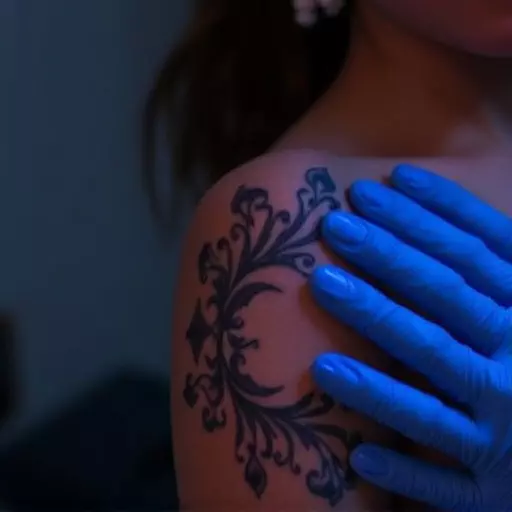Laser or non-laser tattoo lightening in Toledo involves breaking down ink particles for elimination. Laser treatments are precise but risky for darker skin, while non-laser methods like IPL are safer and gentler. Both require multiple sessions for gradual results. Professional, certified services ensure safety and effectiveness. Proper post-treatment care enhances outcomes. Lasers offer faster removal with advanced technology.
Looking to lighten or remove unwanted tattoos? Laser tattoo lightening has emerged as a popular and effective solution in Toledo. This comprehensive guide dives into the world of laser tattoo removal, exploring its understanding, step-by-step process, safety considerations, and non-laser alternatives. From the latest trends to maintenance tips, discover everything you need to know about achieving a lighter, more desired complexion without tattoos.
- Understanding Laser Tattoo Lightening: A Comprehensive Overview
- The Tattoo Lightening Process: Step by Step in Toledo
- Non-Laser Alternatives for Tattoo Lightening
- Safety and Effectiveness Considerations
- Results, Maintenance, and Future Trends
Understanding Laser Tattoo Lightening: A Comprehensive Overview
Laser tattoo lightening is a procedure that utilizes concentrated beams of light to break up pigment in tattoos, allowing for gradual fading over time. Unlike traditional tattoo removal methods, which often involve surgical excision or chemical solutions, laser lightening offers a more non-invasive approach. During the tattoo lightening process in Toledo, specialized lasers are targeted at the ink particles beneath the skin’s surface, fragmenting them into smaller, easier-to-process pieces. The body’s natural immune response then takes over, absorbing and eliminating these broken-down pigment fragments.
This modern technique is particularly effective for individuals seeking to lighten or remove specific parts of a tattoo without completely erasing it. It’s important to note that laser tattoo lightening isn’t suitable for everyone, as the outcome depends on factors like skin type, tattoo age, ink color, and size. Unlike non-laser tattoo lightening methods, which might involve topical creams or chemical peelings, lasers offer precise targeting and minimal side effects. However, multiple sessions are usually required to achieve optimal results, with each session breaking down a portion of the pigment, making it a gradual process that demands patience and commitment.
The Tattoo Lightening Process: Step by Step in Toledo
In Toledo, the tattoo lightening process typically involves a step-by-step approach to help reduce the intensity and visibility of existing tattoos. The journey begins with a consultation where a specialist assesses your tattoo(s), skin type, and desired outcome. They’ll discuss various techniques, including both laser and non-laser methods. Laser tattoo lightening is a precise procedure using targeted beams to break down ink particles, allowing the body’s immune system to eliminate them over time. Non-laser methods may include topical creams or surgical excision, each with its own set of benefits and considerations.
Following the initial consultation, the treatment itself unfolds in stages. For laser lightening, multiple sessions are scheduled, each focusing on specific areas to ensure safe and effective results. During these sessions, a specialized machine emits precise laser pulses that penetrate the skin, targeting the ink without damaging surrounding tissue. In contrast, non-laser methods might require more time and patience, as they involve different techniques to fade or remove tattoos. Regardless of the chosen approach, each step is designed to gradually diminish the tattoo’s appearance while considering patient comfort and safety.
Non-Laser Alternatives for Tattoo Lightening
For those seeking tattoo lightening, laser treatments have long been the go-to method. However, there are valid reasons why some might opt for non-laser alternatives. These options often appeal to individuals with specific skin types or concerns about potential side effects associated with lasers.
Non-laser tattoo lightening processes utilize different technologies like intense pulsed light (IPL) or broad-spectrum lights to break down and fade ink. These methods are generally considered safer for darker skin tones, as they reduce the risk of pigment changes and burning. Moreover, non-laser approaches often prove effective for smaller, more concentrated tattoos, offering a gentle yet visible lightening effect without the potential long-term damage linked to laser exposure. This makes them a viable choice in areas like Toledo where tattoo lightening services are available, catering to diverse client needs beyond traditional laser treatments.
Safety and Effectiveness Considerations
When considering laser tattoo lightening in Toledo or any other location, safety and effectiveness should be your top priorities. The tattoo lightening process uses advanced technology to break up pigment, but it’s crucial to ensure that the facility and equipment meet high standards. Unregulated or non-laser tattoo lightening methods can lead to skin irritation, scarring, and other complications. It’s important to opt for professional, certified services that employ safe, FDA-approved lasers to minimize risks.
Non-laser tattoo lightening alternatives may sound appealing, but they often lack the precision and effectiveness of laser treatments. These methods might not target specific pigment types or depths, leading to inconsistent results. Laser tattoo lightening, on the other hand, offers more control and accuracy, allowing for gradual fading or even complete removal with multiple sessions. Always consult with a reputable professional who can guide you through the process, ensuring both safety and desirable outcomes.
Results, Maintenance, and Future Trends
The results of laser tattoo lightening in Toledo are typically visible after just a few sessions, with significant fading achievable over several weeks or months. This process involves carefully targeting the pigment in the tattoo with high-precision lasers, breaking it down into smaller particles that can be absorbed by the body. Unlike non-laser tattoo lightening methods which may offer quicker initial results but often leave behind remnants of color, laser treatments strive for complete removal or significant reduction, leaving the skin with a smoother, more even tone.
Maintenance after laser tattoo lightening is essential to achieving optimal results. Patients are usually advised to follow specific post-treatment care instructions, such as avoiding direct sunlight and using moisturizers to support healing. While some fading may continue naturally over time, additional treatments can be scheduled as needed to achieve the desired level of clarity. As technology advances, future trends in tattoo lightening could see even more precise lasers, faster treatment times, and enhanced safety measures, making this process a increasingly popular and effective option for those looking to remove unwanted tattoos.


